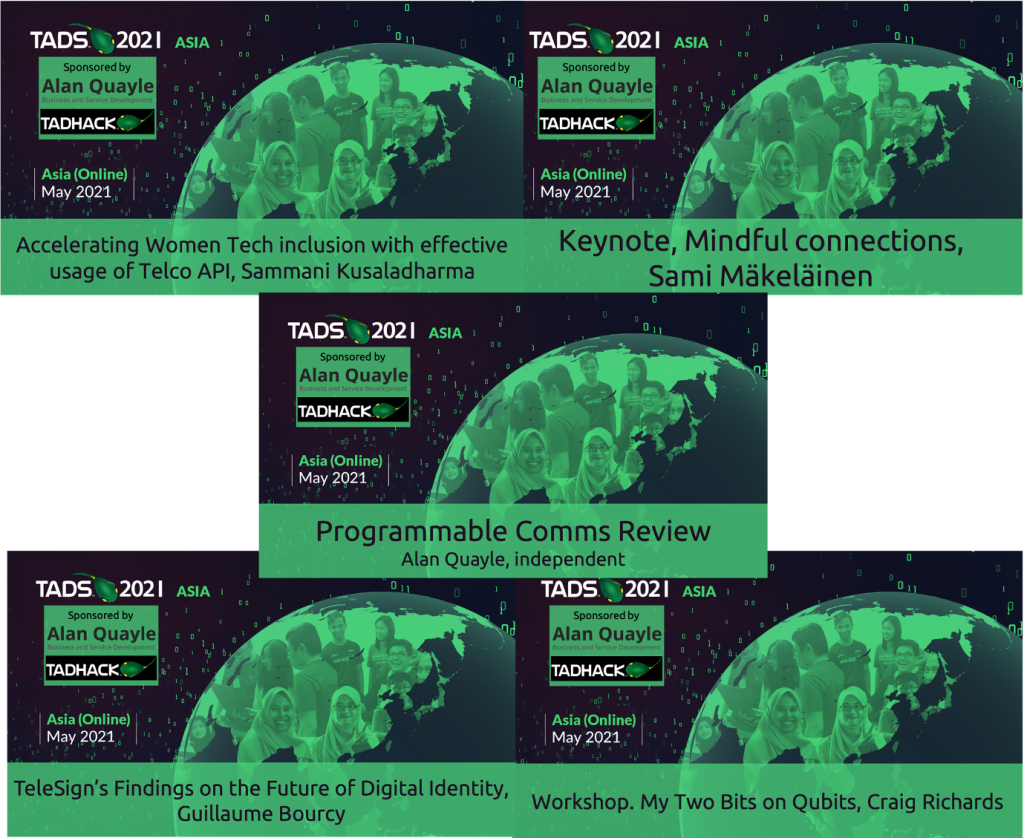One of the fun aspects of running events is crafting the agenda to include content not yet mainstream in programmable communications or under-represented or simply interesting. In this weblog the potpourri includes:
- Keynotes
- Accelerating Women Tech inclusion with effective usage of Telco API, Sammani Kusaladharma, Dialog Axiata
- Mindful Connections, Sami Mäkeläinen, Telstra
- Identity and Fraud. TeleSign’s Findings on the Future of Digital Identity, Guillaume Bourcy, TeleSign
- Workshop. My Two Bits on Qubits, Craig Richards
- Welcome. Programmable Communications Review, Alan Quayle, independent
Accelerating Women Tech inclusion with effective usage of Telco API, Sammani Kusaladharma
I’m a big fan of what Ideamart has achieved. It’s a country-wide innovation ecosystem, that engages the whole country. We’ve worked together since the first TADHack Global in 2014. I’m especially proud Sammani gave this important keynote on Ideamart for Women.
BTW, Ideamart for Women is shortlisted in Tech4Good – Best Mobile Innovation for Emerging Markets, at the GSMA Global Mobile Awards 2021.
To all telcos and CPaaS providers out there: where are your female engagement metrics and ‘for women’ program? Without it you’re simply not achieving your country’s or program’s full potential.
Mindful Connections, Sami Mäkeläinen
APIs are great, at TADHack we have a chant, ‘mash’em up!’ Its so easy to couple systems and services. We do it without a second’s thought. But there is a cost…
Sami sets out an excellent review of the systemic failures being created given the increasing coupling and interactions of communication systems. I highly recommend reviewing the AI Incident Database (AIID), it makes for interesting reading.
Sami reviews some of the thought leadership behind the need for a framework for mindful connections, and interesting case studies. Perrow’s Matrix shows how complexity is increasing across all systems, even something as linear and loosely coupled as a dam has become more complex.
Sami describes some of the tools to address these issues such as pre-mortems, building slack into the system (Amazon Dynamo database is a good example), and openly sharing failures. He leaves us with 3 actionable steps:
- Not every connection is a good connection – what could go wrong?
- Avoid creating brittle systems by focusing purely on efficiency, embrace purposeful inefficiency.
- Help change the culture to be more like safety critical industries. People’s privacy, confidentiality, safety, well-being are critically important to your business. Facebook’s annual, ‘oops we messed up again with your data again’, is no longer tenable.
TeleSign’s Findings on the Future of Digital Identity, Guillaume Bourcy
Digital Identity is a merger of online and offline identities to give a 360 degree view of the customer. The pandemic has increased the importance of this unification given the 20% rise in ecommerce (people buying their shopping online), 400% rise in fraud attacks with 40% of them coming from and humans not just bots.
Merging online and offline identities is tough given the fragmentation, regulations, and the concern of fraud prevention impacting customer conversion. The myth that security and user experience are at odds.
This leads nicely into why TeleSign has been successful in digital identity because the phone number bridges both the offline and online identities. And can, as we’ve seen in previous TeleSign presentations at TADSummit, simultaneously improve customer experience and security.
TADSummit Asia 2021 Workshop: My Two Bits on Qubits, Craig Richards
Every year TADSummit runs workshops, examples from previous years includes:
- Design Thinking & Effectuation by Philippe Vayssac, CIO, Groupama.
- Web 3 by a number of presenters including David Dias, Ben Parsons, Dean Bubley, and Paulo Chainho.
- Privacy by Simon Woodhead. Though the presentation title was ‘Securing my Space Genitalia’!
Craig is a supporter of TADSummit and TADHack since the beginning. He’s been studying the area of quantum computing for a number of years, and brings a much needed practical perspective to this emerging technology. You’re going to see some live quantum computing demos in this workshop! It’s a massive and complex topic, but Craig helps you find your initial steps.
Don’t worry about the math behind quantum computing, Craig keeps it practical with some great demos using the IBM Quantum experience. This practical demo for me made the operations of quantum computing much clearer.
We’re in the exploration phase of finding algorithms that can take advantage of quantum computing’s unique capabilities, and where there is an advantage against classic computing there’ll be $$ available. The systems available online are small, 5-15 qubits, but things are changing fast.
Programmable Communications Review
While each presentation focuses on an important aspect of programmable communications. I provide a quantified market review with projections and important trends. In 2021 across the main programmable communication categories, total revenue is $75B+ across (revenue), growth:
- UCaaS ($33B), 5%
- CCaaS ($18B), 20%
- CPaaS ($11B), 36%
- Business Messaging ($6B), 30%
- Identity verification ($4B with TAM of $25B – $55B as its all about customer experience), 60%+
- Automation tech ($6B with TAM of $30B), 60%+
We’ve seen unprecedented M&A through 2020 into 2021, mainly within programmable communications. We’re going to see in the coming years more enterprise / web companies joining this spree. Will Okta need more than 2FA for mobile authentication? Stripe has just raised $1B for identity verification.
Think of Programmable Communications as telecoms done in a web way, hence why programmable communications will become the target for web / enterprise-focused companies. It’s on a different trajectory to telcos.
If you’re looking for independent analysis, insight, advice, strategy, thought-leadership, business / market development for anything communications / telecoms related. Please get in touch!


One thought on “A Slice of TADSummit: Potpourri”
Comments are closed.